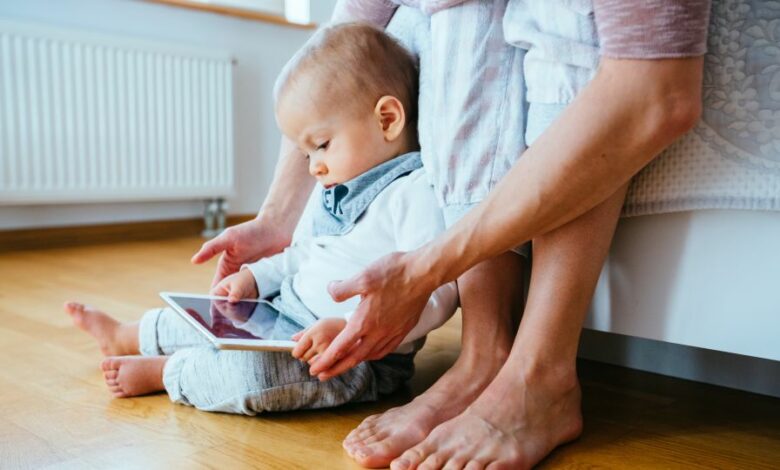
Researchers found that increased use of screen time during infancy was associated with poorer executive functioning once the child was 9 years old, according to the study published Monday in the journal JAMA Pediatrics.
Executive functioning skills are mental processes that “enable us to plan, focus attention, remember instructions, and juggle multiple tasks successfully,” according to the Harvard University Center on the Developing Child.
Those executive functioning skills are important for higher-level cognition, such as emotional regulation, learning, academic achievement and mental health, according to the study. They influence our success socially, academically, professionally and in how we care for ourselves, said Dr. Erika Chiappini, assistant professor of psychiatry and behavioral sciences at the Johns Hopkins University School of Medicine in Baltimore.
“Though these cognitive processes naturally develop from infancy through adulthood, they are also impacted by the experiences that we have and when we have them in our development,” said Chiappini, who was not involved in the study, in an email.
The results support recommendations from the American Academy of Pediatrics, which discourages all screen time before 18 months old, with the exception of video chatting, said Dr. Joyce Harrison, associate professor of psychiatry and behavioral sciences at the Johns Hopkins University School of Medicine. Harrison was not involved in the research.
The study looked at data from Growing Up in Singapore Towards healthy Outcomes, or GUSTO, which surveyed women from all socioeconomic backgrounds during their first trimester of pregnancy. The sample was made up of 437 children who underwent electroencephalography (EEG) scans, which are used to look at the neural pathways of cognitive functions in the brain, at age 1, 18 months and 9 years old.
The parents reported each child’s screen time, and researchers found there was an association between screen time in infancy and attention and executive function at 9 years old, according to the study.
Further research needs to be done, however, to determine if the screen time caused the impairments in executive function or if there are other factors in the child’s environment that predispose them to both more screen time and poorer executive functioning, the study noted.
What children need
In a learning-packed time like infancy, one of the big problems with screen use is that young children aren’t learning much from them, according to AAP.
“There is no substitute for adult interaction, modeling and teaching,” Harrison said.
Babies have a hard time interpreting information presented in two dimensions, such as on screens, and have trouble distinguishing fantasy from reality, Chiappini said.
“Babies and kids are also social learners and very much benefit from the back-and-forth interaction with others (adults and kids) which is hard to achieve with screens,” Chiappini said via email.
When it comes to emotional regulation, infants and toddlers can learn from their caregivers when they model self-control or help to label emotions and appropriate expressions, she added.
For example, you can give a young child options for what they can do when they are mad, like taking a break or breathing deeply instead of inappropriate behaviors like hitting, Harrison said.
Talking about emotions can be too abstract for preschool-age kids, and in those cases using color zones to talk about emotions can be helpful, said Dr. Jenny Radesky, a developmental behavioral pediatrician and associate professor of pediatrics at Michigan Medicine C.S. Mott Children’s Hospital. Radesky was not involved in the research.
Calm and content can be green; worried or agitated can be yellow; and upset or angry can be red, using graphics or images of faces to help kids match what they’re feeling with their color zone. To reinforce it, adults can talk about their own emotions in terms of colors in front of their kids, Radesky said in a CNN previous article.
Parents and children can go through the colors together and come up with calming tools for the different zones, she added.
To strengthen those executive function skills, Harrison says it’s important to provide structured engagement where a child can work through solving problems to the extent that they can at their developmental level — instead of having problems solved for them.
How to get things done without screens
And yet, sometimes parents just need to get the laundry done or attend a work meeting, and screens can feel like an effective distraction.
For very young children, it’s probably still best to avoid screen time, Harrison emphasized.
Instead, try to involve the child in house chores, she said.
“Give your toddler some clothes to fold alongside you while you are trying to get laundry done or keep your infant safely in a position where you can make frequent eye contact while you are engaged your chore,” Harrison said via email.
For older preschoolers, save up your screen time to use strategically, she said.
“For example, their one hour of screen time can be reserved for a time when you have an important video meeting to attend,” Harrison said.
And there is some content that can help teach emotional regulation when your tank is empty. Finding media that is aimed at speaking to children directly about emotions — like Daniel Tiger or Elmo Belly Breathing — can be like a meditation instead of distraction, Radesky previously told CNN.
And you can make screen time works better by engaging your child while they watch, Chiappini said. Ask questions like “what is that character feeling?” and “what could they do to help their friend?” she added.
Raising children is a complex and sometimes overwhelming task, and no caregiver can give their child everything they want to all the time, Radesky said.
Sign up for CNN’s Stress, But Less newsletter. Our six-part mindfulness guide will inform and inspire you to reduce stress while learning how to harness it.




